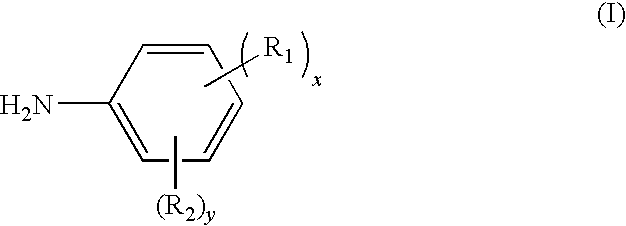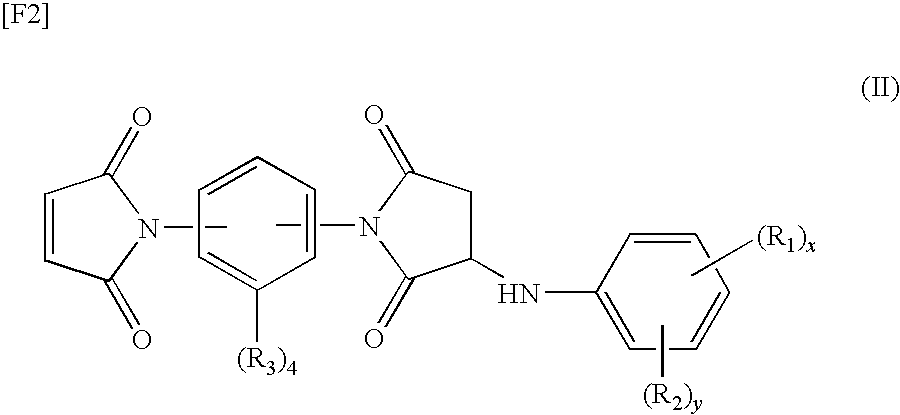Method for producing curing agent having acidic substituent and unsaturated maleimide group, thermosetting resin composition, prepreg, and laminate
a technology of unsaturated maleimide and curing agent, which is applied in the field of producing curing agent with acidic substituent and unsaturated maleimide group, thermosetting resin composition, prepreg, and laminate, can solve the problems of insufficient heat resistance of resin, low yield of bismaleimide compound and aminophenol, and sheet or material exhibits, etc., to achieve excellent adhesion-to-metal foil property, good solubility, and low dielectric properties.
- Summary
- Abstract
- Description
- Claims
- Application Information
AI Technical Summary
Benefits of technology
Problems solved by technology
Method used
Image
Examples
production example 1
Production of Curing Agent (A-1)
[0080]Bis(4-maleimidophenyl)methane (358.00 g), m-aminophenol (54.50 g), and an organic solvent (propylene glycol monomethyl ether) (412.50 g) were added to a reactor which can heat and cool the content (capacity: 2 L) and which was equipped with a thermometer, a stirrer, a reflux cooling tube, and a moisture meter, and reaction was carried out for five hours under reflux, to thereby yield a curing agent (A-1) containing the organic solvent.
production example 2
Production of Curing Agent (A-2)
[0081]Bis(4-maleimidophenyl)methane (358.00 g), p-aminophenol (54.50 g), and an organic solvent (propylene glycol monomethyl ether) (412.50 g) were added to a reactor which can heat and cool the content (capacity: 2 L) and which was equipped with a thermometer, a stirrer, a reflux cooling tube, and a moisture meter, and reaction was carried out for five hours under reflux, to thereby yield a curing agent (A-2) containing the organic solvent.
production example 3
Production of Curing Agent (A-3)
[0082]Bis(4-maleimidophenyl)methane (358.00 g) p-aminobenzoic acid (68.50 g), and an organic solvent (N,N-dimethylacetamide) (426.50 g) were added to a reactor which can heat and cool the content (capacity: 2 L) and which was equipped with a thermometer, a stirrer, a reflux cooling tube, and a moisture meter, and reaction was carried out at 140° C. for five hours, to thereby yield a curing agent (A-3) containing the organic solvent.
PUM
| Property | Measurement | Unit |
|---|---|---|
| glass transition temperature | aaaaa | aaaaa |
| pKa | aaaaa | aaaaa |
| temperature | aaaaa | aaaaa |
Abstract
Description
Claims
Application Information
 Login to view more
Login to view more - R&D Engineer
- R&D Manager
- IP Professional
- Industry Leading Data Capabilities
- Powerful AI technology
- Patent DNA Extraction
Browse by: Latest US Patents, China's latest patents, Technical Efficacy Thesaurus, Application Domain, Technology Topic.
© 2024 PatSnap. All rights reserved.Legal|Privacy policy|Modern Slavery Act Transparency Statement|Sitemap



